The intracameral antibiotics market is projected to grow from USD 57.6 million in 2025 to approximately USD 89.5 million by 2035, recording an absolute increase of USD 31.9 million over the forecast period. This translates into a total growth of 55.4%, with the market forecast to expand at a compound annual growth rate (CAGR) of 4.5% between 2025 and 2035. The overall market size is expected to grow by nearly 1.6X during the same period, supported by increasing demand for advanced ophthalmic infection prevention technologies, growing prevalence of eye surgeries, and rising adoption of prophylactic antibiotic treatments across the global healthcare and surgical sectors.
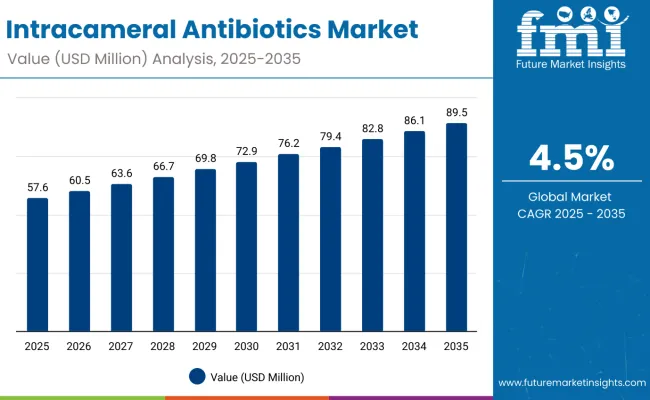
Intracameral Antibiotics Market Key Takeaways
| Metric | Value |
|---|---|
| Estimated Value in (2025E) | USD 57.6 million |
| Forecast Value in (2035F) | USD 89.5 million |
| Forecast CAGR (2025 to 2035) | 4.5% |
Between 2025 and 2030, the intracameral antibiotics market is projected to expand from USD 57.6 million to USD 71.8 million, resulting in a value increase of USD 14.2 million, which represents 44.5% of the total forecast growth for the decade. This phase of development will be shaped by increasing ophthalmic surgical procedures, rising demand for infection prevention solutions, and growing utilization in cataract surgery applications. Medical device manufacturers and ophthalmic specialists are expanding their antibiotic delivery capabilities to address the growing preference for effective prophylactic treatments in intracameral injection systems.
From 2030 to 2035, the market is forecast to grow from USD 71.8 million to USD 89.5 million, adding another USD 17.7 million, which constitutes 55.5% of the overall ten-year expansion. This period is expected to be characterized by the expansion of advanced ophthalmic surgical technologies, the integration of AI-powered surgical planning systems for premium intracameral antibiotic products, and the development of enhanced delivery mechanisms for specialized applications. The growing emphasis on preventive ophthalmic care and surgical outcome optimization will drive demand for intelligent antibiotic delivery systems with enhanced efficacy and improved therapeutic effectiveness.
Between 2020 and 2024, the intracameral antibiotics market experienced steady growth, driven by increasing awareness of post-surgical infections and growing recognition of prophylactic antibiotic systems' superior infection prevention capabilities across hospital and surgical center applications. The market developed as healthcare providers recognized the potential for intracameral antibiotic technology to enhance surgical outcomes while meeting modern healthcare requirements for infection control and patient safety. Technological advancement in antibiotic formulation and delivery systems began emphasizing the critical importance of maintaining therapeutic concentrations while minimizing systemic exposure and improving surgical success rates.
The intracameral antibiotics market represents a specialized healthcare opportunity at the intersection of ophthalmology, infection prevention, and surgical safety, with the market projected to expand from USD 57.6 million in 2025 to USD 89.5 million by 2035 at a 4.5% CAGR-a 1.6X growth driven by increasing cataract surgery volumes, growing awareness of endophthalmitis prevention, and the integration of prophylactic antibiotic protocols into standard ophthalmic procedures.
This convergence opportunity leverages the critical need for infection prevention in ocular surgery, the established efficacy of intracameral administration, and advances in antibiotic formulations to create products that offer superior protection against endophthalmitis. Cefuroxime leads with 50.4% market share due to its proven efficacy and safety profile, while hospitals dominate demand as the primary setting for ophthalmic procedures. Geographic growth is strongest in China (6.7% CAGR) and India (6.1% CAGR), where increasing surgical volumes and improving healthcare infrastructure create ideal market conditions.
Pathway A - Cefuroxime Product Leadership. The dominant antibiotic offers superior efficacy against gram-positive bacteria and established safety profiles essential for intracameral use. Companies developing advanced cefuroxime formulations with enhanced stability, improved delivery systems, and optimized dosing protocols will capture the leading product segment. Expected revenue pool: USD 40-50 million.
Pathway B - Hospital-Based Market Integration. The largest end-user segment benefits from growing surgical volumes and increased focus on infection prevention protocols. Providers developing comprehensive hospital solutions with integrated delivery systems, staff training programs, and quality assurance protocols will dominate this primary market. Opportunity: USD 55-65 million.
Pathway C - Advanced Drug Delivery Systems. Next-generation products require sophisticated delivery mechanisms capable of precise dosing, maintained sterility, and ease of administration during surgical procedures. Companies investing in innovative delivery technologies, pre-filled syringes, and automated injection systems will create competitive differentiation and premium positioning. Revenue uplift: USD 15-25 million.
Pathway D - Geographic Expansion in Emerging Markets. China and India's rapidly growing healthcare sectors and increasing surgical volumes create substantial opportunities. Local regulatory partnerships, adapted formulations for regional needs, and competitive pricing strategies enable market penetration in these high-growth regions. Pool: USD 20-30 million.
Pathway E - Specialty Clinic Expansion. Ambulatory surgical centers and specialty clinics represent growing opportunities for streamlined procedures and improved efficiency. Developing products tailored for outpatient settings, simplified protocols, and cost-effective solutions addresses this expanding segment. Expected upside: USD 10-15 million
Market expansion is being supported by the increasing global prevalence of ophthalmic surgical procedures and the corresponding shift toward prophylactic antibiotic technologies that can provide superior infection prevention while meeting healthcare requirements for surgical safety and patient outcome optimization. Modern healthcare providers and ophthalmic surgeons are increasingly focused on incorporating intracameral antibiotics to enhance surgical outcomes while satisfying demands for advanced infection control technologies and evidence-based prophylactic treatments.
Intracameral antibiotics' proven ability to deliver superior infection prevention, localized therapeutic concentrations, and surgical outcome enhancement makes them essential treatments for high-risk ophthalmic procedures and post-surgical care applications.
The growing emphasis on preventive surgical care and evidence-based treatment approaches is driving demand for high-quality intracameral antibiotic products that can support distinctive surgical experiences and comprehensive infection prevention across cataract surgery, vitreoretinal procedures, and other ophthalmic interventions.
Healthcare provider preference for treatments that combine infection prevention excellence with localized delivery capabilities is creating opportunities for innovative pharmaceutical implementations in both hospital and ambulatory surgical center applications. The rising influence of surgical outcome optimization and patient safety protocols is also contributing to increased adoption of premium intracameral antibiotic products that can provide authentic infection prevention characteristics.
The market is segmented by product type and end user. The demand for products is divided into cefuroxime, moxifloxacin, vancomycin, and others. Based on end user, the market is categorized into hospitals, specialty clinics, ambulatory surgical centers, and others.

The cefuroxime segment is projected to account for 50.4% of the intracameral antibiotics market in 2025, reaffirming its position as the leading product category. Pharmaceutical manufacturers and ophthalmic surgeons increasingly utilize cefuroxime technology for its superior efficacy, proven safety profile, and broad-spectrum antimicrobial activity in prophylactic intracameral applications across diverse surgical settings. Cefuroxime's established clinical evidence and proven performance directly address the medical requirements for effective infection prevention and reliable therapeutic outcomes in ophthalmic surgical procedures.
This product segment forms the foundation of modern prophylactic ophthalmic care applications, as it represents the antibiotic with the greatest clinical evidence potential and established compatibility across multiple surgical systems. Manufacturer investments in formulation optimization and delivery enhancement continue to strengthen adoption among pharmaceutical producers. With healthcare providers prioritizing patient safety and surgical outcomes, cefuroxime systems align with both clinical effectiveness objectives and infection prevention requirements, making them the central component of comprehensive prophylactic strategies. The segment is projected to maintain its leadership position at 51.0% by 2035.
Moxifloxacin holds the second-largest market share at 22.3% in 2025, expected to slightly decrease to 21.8% by 2035, while vancomycin accounts for 27.3% in 2025, projected to maintain 27.2% by 2035.
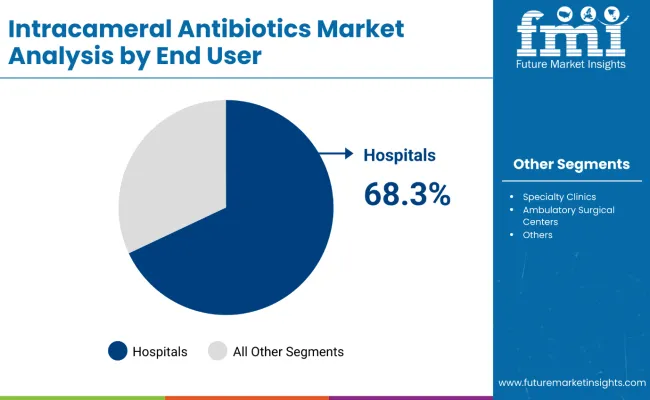
Hospitals are projected to represent the largest share of intracameral antibiotics demand in 2025 at 68.3%, underscoring their critical role as the primary end user for prophylactic antibiotic treatments in ophthalmic surgical procedures and infection prevention protocols.
Healthcare providers and ophthalmic surgeons prefer intracameral antibiotic systems for their exceptional infection prevention capabilities, localized delivery features, and ability to maintain therapeutic concentrations while supporting surgical outcome requirements during ophthalmic procedures. Positioned as essential treatments for high-risk surgical patient management, intracameral antibiotics offer both infection prevention and surgical outcome enhancement advantages.
The segment is supported by continuous growth in ophthalmic surgical procedures and the growing availability of advanced prophylactic antibiotic technologies that enable enhanced surgical outcomes and infection prevention at the hospital level. Additionally, healthcare systems are investing in surgical safety technologies to support patient outcome improvement and healthcare cost optimization. As ophthalmic surgery continues to evolve and providers seek superior infection prevention solutions, hospital applications will continue to dominate the end user landscape while supporting technology advancement and surgical care optimization strategies. The segment is expected to maintain its leadership position at 67.8% by 2035.
Specialty clinics account for 15.4% in 2025, projected to increase to 16.3% by 2035, while ambulatory surgical centers hold 12.2% in 2025, expected to slightly decrease to 11.7% by 2035. Other end users represent 4.1% in 2025, projected to remain stable at 4.2% by 2035.
The intracameral antibiotics market is advancing steadily due to increasing ophthalmic surgical procedures and growing demand for prophylactic infection prevention solutions that emphasize superior surgical outcomes across hospital and surgical center applications. However, the market faces challenges, including high treatment costs compared to traditional prophylactic alternatives, regulatory complexity in antibiotic approval processes, and competition from systemic antibiotic treatments. Innovation in delivery mechanism enhancement and therapeutic efficacy improvement continues to influence market development and expansion patterns.
Expansion of Prophylactic Surgical Care Protocols
The growing adoption of intracameral antibiotics in comprehensive ophthalmic surgical procedures and preventive infection control applications is enabling healthcare providers to develop protocols that provide distinctive surgical protection capabilities while commanding premium positioning and enhanced surgical outcome characteristics. Advanced prophylactic protocols provide superior infection prevention while allowing more sophisticated surgical risk management across various procedure categories and treatment segments. Healthcare systems are increasingly recognizing the competitive advantages of prophylactic antibiotic positioning for comprehensive surgical care development and ophthalmic specialty market penetration.
Integration of Advanced Delivery Systems and Pharmaceutical Innovation
Modern intracameral antibiotic suppliers are incorporating advanced delivery mechanisms, sustained-release formulations, and targeted therapeutic systems to enhance efficacy, improve surgical outcomes, and meet healthcare provider demands for reliable and effective prophylactic solutions. These programs improve treatment performance while enabling new applications, including personalized surgical care and optimized infection prevention systems. Advanced pharmaceutical integration also allows suppliers to support premium market positioning and clinical excellence leadership beyond traditional prophylactic products.
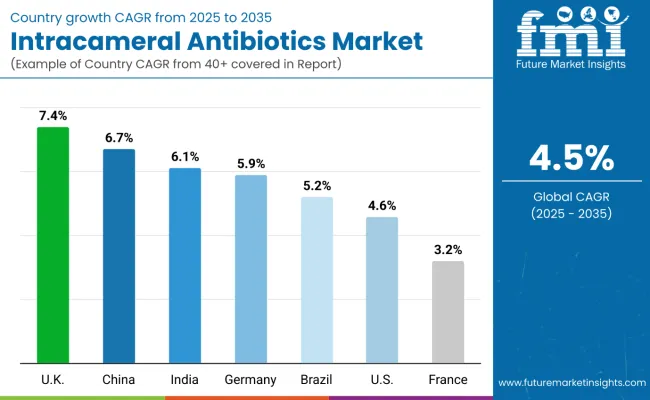
| Country | CAGR (2025 to 2035) |
|---|---|
| UK | 7.4% |
| China | 6.7% |
| India | 6.1% |
| Germany | 5.9% |
| Brazil | 5.2% |
| USA | 4.6% |
| France | 3.2% |
The intracameral antibiotics market is experiencing robust growth globally, with the UK leading at a 7.4% CAGR through 2035, driven by advanced ophthalmic surgical infrastructure, increasing surgical procedures, and rising adoption of prophylactic infection prevention technologies. China follows at 6.7%, supported by growing healthcare investments, expanding surgical capabilities, and rising focus on surgical outcome optimization. India shows growth at 6.1%, emphasizing healthcare system modernization and expanding ophthalmic surgical capabilities.
Germany demonstrates 5.9% growth, prioritizing advanced surgical innovation and precision infection prevention solutions. Europe records 5.0%, focusing on healthcare technology integration and surgical outcome optimization. Brazil exhibits 5.2% growth, supported by healthcare modernization and expanding surgical infrastructure. The USA demonstrates 4.6% growth, emphasizing advanced surgical care innovation and comprehensive infection prevention solutions.
The report covers an in-depth analysis of 40+ countries; six top-performing countries are highlighted below.
Revenue from intracameral antibiotics in the United Kingdom is projected to exhibit exceptional growth with a CAGR of 7.4% through 2035, driven by advanced ophthalmic surgical infrastructure and rising awareness of surgical infection prevention across major medical centers and specialized surgical facilities. The country's growing surgical market and increasing adoption of prophylactic antibiotic technologies are creating substantial demand for intracameral solutions in both NHS and private healthcare applications. Major pharmaceutical manufacturers and ophthalmic companies are establishing comprehensive distribution and clinical support capabilities to serve both domestic surgical needs and regional export markets.
Revenue from intracameral antibiotics in China is expanding at a CAGR of 6.7%, supported by growing healthcare investments, increasing surgical procedure volumes, and expanding ophthalmic care infrastructure with advanced infection prevention capabilities. The country's developing healthcare ecosystem and expanding pharmaceutical manufacturing sector are driving demand for sophisticated prophylactic treatments across both urban healthcare facilities and emerging regional surgical centers. International pharmaceutical companies and domestic healthcare manufacturers are establishing comprehensive production and clinical support capabilities to address growing market demand for advanced infection prevention solutions.
Revenue from intracameral antibiotics in India is projected to grow at a CAGR of 6.1% through 2035, driven by healthcare system modernization initiatives, expanding ophthalmic surgical capabilities, and growing focus on infection prevention requiring advanced prophylactic solutions. India's developing healthcare infrastructure and increasing emphasis on surgical outcome optimization are creating substantial demand for both standard and premium intracameral antibiotic varieties. Leading pharmaceutical companies and ophthalmic specialists are establishing comprehensive clinical strategies to serve both Indian markets and growing regional healthcare demand.
Revenue from intracameral antibiotics in Germany is projected to grow at a CAGR of 5.9% through 2035, supported by the country's advanced surgical care sector, innovation leadership capabilities, and established market for premium infection prevention solutions. German healthcare providers and pharmaceutical manufacturers prioritize clinical excellence, surgical safety, and technological advancement, making intracameral antibiotics essential treatments for both hospital surgical protocols and specialized ophthalmic care management. The country's comprehensive healthcare ecosystem and clinical adoption patterns support continued market development.
Revenue from intracameral antibiotics in Brazil is projected to grow at a CAGR of 5.2% through 2035, supported by the country's healthcare technology integration initiatives, expanding surgical care development sector, and established expertise in pharmaceutical applications. Brazilian healthcare providers' focus on clinical excellence, surgical outcome optimization, and infection prevention creates steady demand for effective prophylactic products. The country's attention to healthcare quality and patient safety drives consistent adoption across both traditional hospital and emerging surgical center applications.
Revenue from intracameral antibiotics in Europe is projected to grow at a CAGR of 5.0% through 2035, supported by the region's clinical excellence priorities, advanced healthcare development sector, and established focus on surgical safety and infection prevention innovation. European healthcare providers' emphasis on evidence-based medicine, clinical outcomes, and patient-centered care creates steady demand for advanced prophylactic products. The region's attention to healthcare quality and clinical effectiveness drives consistent adoption across both public and private healthcare applications.
Revenue from intracameral antibiotics in the United States is projected to grow at a CAGR of 4.6% through 2035, supported by the country's advanced surgical care sector, pharmaceutical innovation capabilities, and established reputation for producing superior infection prevention solutions while working to enhance surgical outcome precision and develop high-quality prophylactic technologies. The USA pharmaceutical industry continues to benefit from its reputation for clinical excellence while focusing on therapeutic innovation and regulatory compliance.
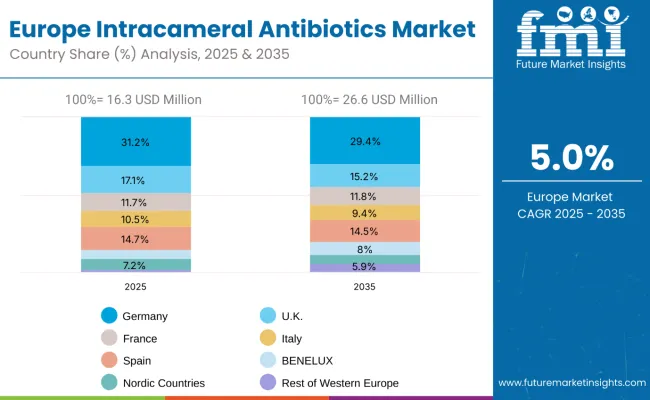
The intracameral antibiotics market in Europe is projected to grow at a CAGR of 5.0% from 2025 to 2035. Germany is expected to maintain its leadership position with a 31.2% market share in 2025, declining slightly to 29.4% by 2035, supported by its precision pharmaceutical technology sector, advanced healthcare infrastructure, and clinical capabilities serving regional and international markets.
Spain follows with a 14.7% share in 2025, projected to reach 14.5% by 2035, driven by expanding surgical capabilities and healthcare modernization initiatives. The United Kingdom holds a 17.1% share in 2025, expected to decrease to 15.2% by 2035, supported by advanced surgical care and clinical excellence standards, though facing challenges from market competition.
France accounts for 11.7% in 2025, projected to maintain 11.8% by 2035, while Italy contributes 10.5% in 2025, declining to 9.4% by 2035. BENELUX represents 5.6% in 2025, increasing to 8.0% in 2035, while Nordic Countries hold 7.2% in 2025, decreasing to 5.9% by 2035. The Rest of Western Europe region is expected to account for 2.1% in 2025, increasing significantly to 5.9% by 2035, reflecting growth dynamics across emerging markets.
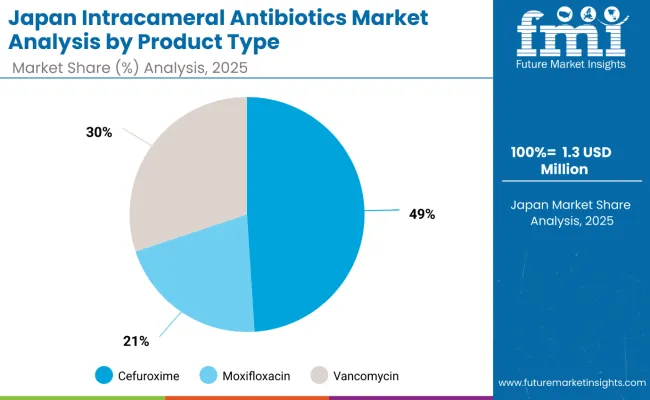
The intracameral antibiotics market in Japan demonstrates strong adoption of established prophylactic treatments, with cefuroxime maintaining market leadership at 49.0% market share, reflecting preference for proven clinical efficacy and established safety profiles in Japanese surgical applications.
Vancomycin accounts for 30.1% market share, supported by its effectiveness against gram-positive infections and established clinical protocols in Japanese healthcare systems. Moxifloxacin holds 20.9% market share, driven by its broad-spectrum activity and growing adoption in specialized ophthalmic procedures.
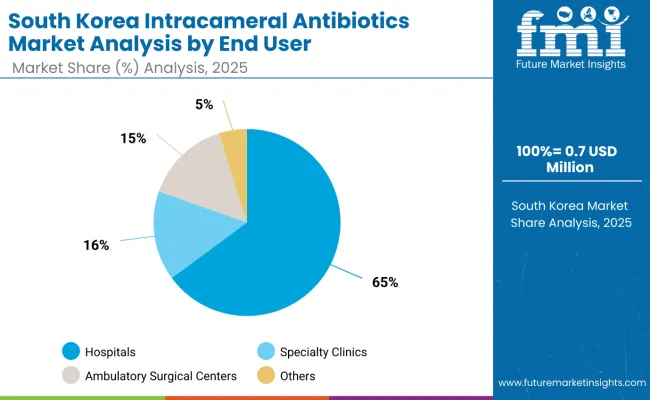
The intracameral antibiotics market in South Korea shows strong hospital dominance with 64.9% market share, reflecting the country's hospital-centric healthcare delivery system and concentration of ophthalmic surgical procedures in tertiary care facilities.
Ambulatory surgical centers account for 14.7% market share, supported by growing outpatient surgical capabilities and healthcare system modernization initiatives. Specialty clinics hold 15.5% market share, driven by specialized ophthalmic care delivery and referral networks. Others represent 4.9% market share, encompassing various healthcare delivery settings and emerging care models.
The intracameral antibiotics market is characterized by competition among established pharmaceutical companies, specialized ophthalmic manufacturers, and integrated healthcare technology suppliers. Companies are investing in advanced formulation technologies, delivery system optimization, application-specific product development, and comprehensive clinical support capabilities to deliver consistent, high-performance, and reliable intracameral antibiotic products. Innovation in efficacy enhancement, safety optimization, and customized surgical compatibility is central to strengthening market position and healthcare provider satisfaction.
Alcon leads the market with a 25.2% share, focusing on comprehensive ophthalmic solutions and advanced surgical technologies, offering premium intracameral antibiotic products with emphasis on clinical excellence and surgical outcome optimization. Other key players provide 74.8% combined market share with specialized pharmaceutical and infection prevention capabilities focusing on innovation and clinical support. The competitive landscape includes Aspen Pharmacare delivering integrated pharmaceutical solutions with emphasis on healthcare system compatibility and therapeutic excellence.
Pfizer Inc. specializes in pharmaceutical technologies with focus on clinical efficacy and regulatory compliance. Abbott Laboratories focuses on healthcare innovation with emphasis on advanced therapeutic systems and surgical outcome optimization. Novartis AG provides pharmaceutical excellence with focus on clinical research and market development. Merck & Co., Inc. offers comprehensive pharmaceutical solutions emphasizing therapeutic innovation and clinical advancement. Cosmo Pharmaceuticals N.V. focuses on specialized pharmaceutical delivery with emphasis on targeted therapeutic applications and clinical effectiveness.
| Items | Values |
|---|---|
| Quantitative Units (2025) | USD 57.6 million |
| Product Type | Cefuroxime, Moxifloxacin, Vancomycin, Others |
| End User | Hospitals, Specialty Clinics, Ambulatory Surgical Centers, Others |
| Regions Covered | North America, Europe, East Asia, South Asia & Pacific, Latin America, Middle East & Africa |
| Countries Covered | United States, Canada, United Kingdom, Germany, France, China, Japan, South Korea, India, Brazil, Australia and 40+ countries |
| Key Companies Profiled | Alcon, Aspen Pharmacare, Pfizer Inc., Abbott Laboratories, Novartis AG, Merck & Co., Inc., Cosmo Pharmaceuticals N.V. |
| Additional Attributes | Dollar sales by product type and end user, regional demand trends, competitive landscape, technological advancements in pharmaceutical delivery, healthcare integration initiatives, surgical outcome optimization programs, and clinical excellence enhancement strategies |
By North America
By Europe
By East Asia
By South Asia & Pacific
By Latin America
By Middle East & Africa
The global intracameral antibiotics market is valued at USD 57.6 million in 2025.
The size for the intracameral antibiotics market is projected to reach USD 89.5 million by 2035.
The intracameral antibiotics market is expected to grow at a 4.5% CAGR between 2025 and 2035.
The key product type segments in the intracameral antibiotics market are cefuroxime, moxifloxacin, vancomycin, and others.
In terms of end user, hospitals segment is set to command 68.3% share in the intracameral antibiotics market in 2025.






Our Research Products

The "Full Research Suite" delivers actionable market intel, deep dives on markets or technologies, so clients act faster, cut risk, and unlock growth.

The Leaderboard benchmarks and ranks top vendors, classifying them as Established Leaders, Leading Challengers, or Disruptors & Challengers.

Locates where complements amplify value and substitutes erode it, forecasting net impact by horizon

We deliver granular, decision-grade intel: market sizing, 5-year forecasts, pricing, adoption, usage, revenue, and operational KPIs—plus competitor tracking, regulation, and value chains—across 60 countries broadly.

Spot the shifts before they hit your P&L. We track inflection points, adoption curves, pricing moves, and ecosystem plays to show where demand is heading, why it is changing, and what to do next across high-growth markets and disruptive tech

Real-time reads of user behavior. We track shifting priorities, perceptions of today’s and next-gen services, and provider experience, then pace how fast tech moves from trial to adoption, blending buyer, consumer, and channel inputs with social signals (#WhySwitch, #UX).

Partner with our analyst team to build a custom report designed around your business priorities. From analysing market trends to assessing competitors or crafting bespoke datasets, we tailor insights to your needs.
Supplier Intelligence
Discovery & Profiling
Capacity & Footprint
Performance & Risk
Compliance & Governance
Commercial Readiness
Who Supplies Whom
Scorecards & Shortlists
Playbooks & Docs
Category Intelligence
Definition & Scope
Demand & Use Cases
Cost Drivers
Market Structure
Supply Chain Map
Trade & Policy
Operating Norms
Deliverables
Buyer Intelligence
Account Basics
Spend & Scope
Procurement Model
Vendor Requirements
Terms & Policies
Entry Strategy
Pain Points & Triggers
Outputs
Pricing Analysis
Benchmarks
Trends
Should-Cost
Indexation
Landed Cost
Commercial Terms
Deliverables
Brand Analysis
Positioning & Value Prop
Share & Presence
Customer Evidence
Go-to-Market
Digital & Reputation
Compliance & Trust
KPIs & Gaps
Outputs
Full Research Suite comprises of:
Market outlook & trends analysis
Interviews & case studies
Strategic recommendations
Vendor profiles & capabilities analysis
5-year forecasts
8 regions and 60+ country-level data splits
Market segment data splits
12 months of continuous data updates
DELIVERED AS:
PDF EXCEL ONLINE
Antibiotics Active Pharmaceutical Ingredient (API) Market - Growth & Forecast 2025 to 2035
Animal Antibiotics and Antimicrobials Market Size and Share Forecast Outlook 2025 to 2035
Peptide Antibiotics Market
Veterinary Antibiotics Market Size and Share Forecast Outlook 2025 to 2035
Animal Feed Antibiotics Market - Size, Share, and Forecast Outlook 2025 to 2035
Animal Antimicrobials and Antibiotics Market Size and Share Forecast Outlook 2025 to 2035

Thank you!
You will receive an email from our Business Development Manager. Please be sure to check your SPAM/JUNK folder too.
Chat With
MaRIA